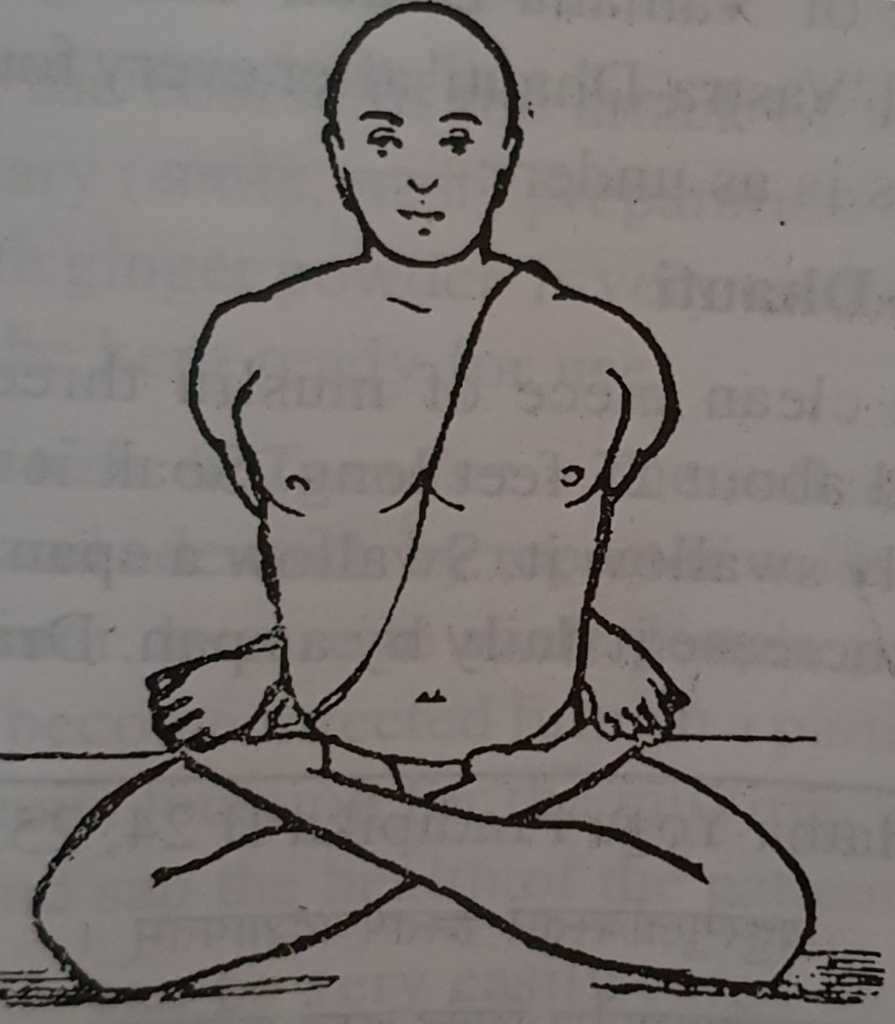The prolonged Catarrh is likely to penetrate further downwards affecting the muscles of the inner air-passages and their mucous linings. This results in Asthma which is characterised by difficulty in breathing and constant wheezing and coughing. This disease is dangerous for life and extremely troublesome*. Medicines afford temporary relief to the patient but the permanent cure is in Yoga which eradicates its root cause, the Catarrh.
The treatment of Asthma by Yogic methods extends over two to six months according to the condition of the patient.
Nourishing diet at regular intervals only should be taken. Cough producing objects such as rice, buffalo’s milk, ‘mas ki dal’, cabbage; and such other things and sour objects should be avoided. Hard exercise, exertion and worry are harmful. Morning Sun-baths and doing the ‘Asanas’, prescribed below, in open Sun-shine help the treatment.
‘Sutra-neti‘ should be regularly done every day in the morning. This should be followed by ‘Vyutkrama neti‘ but cow’s milk should be substituted for water in this case.
After this, ‘Vamana-Dhauti‘ with luke warm water in which a piece of ginger has been boiled should be practised. Then take a quarter litre of milk with a piece of ginger boiled in it and sip it when it is luke warm through the nose.
Then, prepare a comfortable seat on the ground by spreading a mat and a carpet in the open sunshine. Practise the ‘Kapala-bhati Pranayama‘ for five minutes. After that, sit in the ‘Baddha-Padmasana‘ for as long as you can upto the length of half an hour. Its process is described as under : –
Baddha-padmasana
Sit with the legs stretched forward. Then lift the right foot and place Its heel at the root of the left thigh. And similarly the left heel at the root of the right. Now, cross the hands behind the back and take hold of the toes, the right toe with the right hand and the left toe with the left. Place the chin firmly on the breast and look the tip of the nose. This strengthens the lungs and cures Asthma.
After the ‘Baddha-Padmasana’ ‘Sarvangasana‘ should also be done.
In place of ‘Vamana-Dhauti‘ there should be substituted ‘Vastra-Dhauti‘ after every fourth day. Its process is as under :
Vastra-Dhauti
Take a clean piece of muslin three inches broad and about 25 feet long. Soak it in water and slowly swallow it. Swallow a span the first day and increase it daily by a span. Draw it out again.**
During the course of the attack of wheezing the electuary (अवलेह, चटनी) preparation of honey mixed with ginger powder is very useful to lick. It should be kept ready for use.
*Cf. कामं प्राणहरा रोगा बहवो न तुते तथा ।
यथा श्वासश्च हिक्का च हरत: प्राणमाशु वै ॥
(Yoga Ratnakar p. 589, Verse 3)
Tr:- Every disease is dangerous for life, without doubt, but not so much as Hic-cough and Asthma which kill a person in no time.
**Cf. Hatha Yoga Pradipika II 24, 25
चतुरंगुलबिस्तारं हस्तपंचदशायतम ।
गुरूपदिष्टमार्गेण सिक्ंत वस्त्रं शनैर्ग्रसेत् ॥
पुन: प्रत्याहरेच्चैतदुदितं धौति कर्म तत् ॥ 24
कासश्वासप्लीहकुष्टं कफरोगाश्च विंशति: ।
धौति कर्म प्रभावेन प्रयांत्येव न संशयः ॥ 25
Tr:- Take a clean wet piece of cloth 4 fingers broad and 15 spans long and slowly swallow it according to the instructions of the Guru.
Draw it out again. This is called ‘Dhauti’ and removes Cough, Asthma, ‘Pleeha’ (splenetic diseases), leprosy and other diseases brought on by phlegm.

